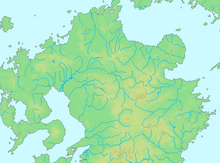Eta Funayama Kofun
This article needs additional citations for verification. (July 2021) |

Coordinates: 32°58′16.63″N 130°36′0.02″E / 32.9712861°N 130.6000056°E

Funayama
Kofun

The Eta Funayama Kofun (Japanese: 江田船山古墳) is a kofun, or burial mound, that is located in Nagomi, Kumamoto in Japan.[1] The Kofun was designated a National Historic Site of Japan in 1951.[2] The designation includes Tsukabōzu Kofun (塚坊主古墳) and Kokuzōtsuka Kofun (虚空蔵塚古墳). Artifacts that were excavated from Eta Funayama Kofun and have been designated National Treasures of Japan are now at the Tokyo National Museum (see List of National Treasures of Japan).[3]
Eta Funayama Sword[]
The Eta Funayama Burial Mound Sword (江田船山古墳鉄剣, eta funayama kofun tekken) is a 5th-century ancient iron sword excavated from Eta Funayama Kofun in 1873. The inscription on the blade indicates that the sword was made during the era of Emperor Yūryaku in the 5th century. The burial objects from the Eta Funayama site, including this sword, have been designated National Treasures of Japan in the category archaeological materials.
Inscription[]
The original inscription and translation is as follows:[4]
治天下獲□□□鹵大王,奉□典曹人名无□弖,八月中,用大錡釜併四尺廷刀八十練□十捃□寸上□□刀。服此刀者□□子孫注ゝ得其恩也,不失其所統。作刀者名伊太加,書者張安也。
In the reign of the great ruler Wa[kataki]ru who ruled the land, in the eighth month an official in service by the name of Mu...te used a large cauldron and a four-foot court [?] sword. Refining and selecting the metal many times,... sword. He who wears this sword...; his descendants will successively obtain its favours, and not lose that which they control. The name of the person who made the sword is Itaka; the text was written by Zhang An.
Portions of the text are now illegible (rendered above as □ in the Japanese inscription, or ellipses in the English translation), making it difficult to interpret. The name of the ruler, Wakatakiru, is reconstructed from evidence on the Inariyama burial mound sword.
Note[]
- ^ "江田船山古墳 / 観光情報TOP / 和水町". www.town.nagomi.lg.jp. Retrieved 2021-07-08.
- ^ 第2版, 日本大百科全書(ニッポニカ),デジタル大辞泉,国指定史跡ガイド,ブリタニカ国際大百科事典 小項目事典,百科事典マイペディア,防府市歴史用語集,精選版 日本国語大辞典,旺文社日本史事典 三訂版,世界大百科事典. "江田船山古墳とは". コトバンク (in Japanese). Retrieved 2021-07-08.
- ^ 肥後江田船山古墳出土品 [Excavated Artefacts from Higo Eda Funayama Kofun] (in Japanese). Agency for Cultural Affairs. Retrieved 28 June 2012.
- ^ Seeley, Christopher. A History of Writing in Japan. Brill Academic Publishers. 1991. pp 24-25. ISBN 90-04-09081-9.
References[]
- Seeley, Christopher (1991). A History of Writing in Japan. Brill Academic Publishers. pp. 24–25. ISBN 90-04-09081-9.
- Kofun period
- Old Japanese texts
- National Treasures of Japan
- Individual Japanese swords
- Kofun
- Japanese history stubs
